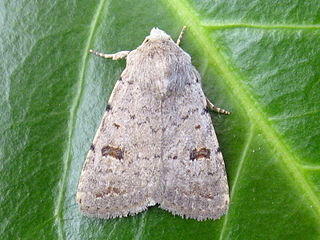
Heliothis is a genus of moths in the family Noctuidae. It was first described by Ferdinand Ochsenheimer in 1816. Some of the species have larvae which are agricultural pests on crop species such as tobacco, cotton, soybean and pigeon pea. Some species originally in this genus have been moved to other genera, see Chloridea and Helicoverpa.

Acontiinae is a subfamily of bird dropping moths in the family Noctuidae. There are more than 50 genera and 430 described species in Acontiinae, found worldwide in temperate and tropical climates.

Hadenini is a tribe of cutworm or dart moths in the family Noctuidae. There are more than 140 genera and 1,000 described species in Hadenini, found worldwide.

Amastus is a genus of moths in the family Erebidae. The genus was erected by Francis Walker in 1855.

Acontia is a genus of moths of the family Noctuidae. The genus was named by Ferdinand Ochsenheimer in 1816. Eusceptis, Pseudalypia and Spragueia are sometimes included in the present genus, but here they are tentatively treated as different pending further research. Many species of Tarache were also once placed here.

Caradrina is a genus of moths of the family Noctuidae, erected by Ferdinand Ochsenheimer in 1816 and divided into eight subgenera. These include Paradrina and Platyperigea, which some authors treat as separate genera. By 1989, it comprised 189 described species.

Dargida is a genus of moths of the family Noctuidae.

Episema is a genus of moths of the family Noctuidae. The genus was described by Ochsenheimer in 1816.

Hampsonodes is a genus of moths in the family Noctuidae.
Hypercalymnia is a genus of moths of the family Noctuidae. The genus was erected by George Hampson in 1909.

Leucania is a genus of moths of the family Noctuidae first described by Ferdinand Ochsenheimer in 1816.

Ophiusa is a genus of moths in the family Erebidae erected by Ferdinand Ochsenheimer in 1816.

Plusia is a genus of moths of the family Noctuidae. The genus was erected by Ferdinand Ochsenheimer in 1816.

Polia is a genus of moths of the family Noctuidae described by Ochsenheimer in 1816.

Simyra is a genus of moths of the family Noctuidae. The genus was described by Ochsenheimer in 1816.

Tarache is a genus of moths of the family Noctuidae erected by Jacob Hübner. It includes most former New World Acontia species. Lepidoptera and Some Other Life Forms and The Global Lepidoptera Names Index report this name as a synonym of Acontia.

Trachea is a genus of moths of the family Noctuidae erected by Ferdinand Ochsenheimer in 1816.

Heliothinae is a small, cosmopolitan subfamily of moths in the family Noctuidae, with about 400 described species worldwide. It includes a number of economically significant agricultural pest species, such as Helicoverpa armigera and Helicoverpa zea.
Noctuini is a tribe of owlet moths in the family Noctuidae. There are at least 520 described species in Noctuini.

















